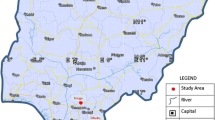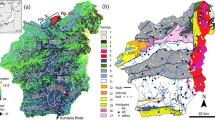Abstract
This research investigated the hydrogeological aspects associated with severe gulling and landsliding on a vulnerable sedimentary terrain in the context of the newly identified deformation patterns and large numbers of recently discovered scars clustering slopes on identical coordinates. Results of field survey, remote sensing, vertical electrical sounding and experimental analyses were presented to explain the causes and mechanisms of the mass movements ravaging the terrain. A digital elevation model accurately captured the diverse geomorphologic elements including landslide scars, hills, ridges, valleys, plains and rivers that matched field observations. The model aided the identification of previously unknown steep incised channels, active headcuts, unstable side walls and a seasonal river flowing near the slopes having large number of landslide scars. It was observed that areas that lay on higher elevations where the clusters occur were dominated by fresh scars while the moderate to low elevations were dominated by older ones. Majority of the slope failures initiated within the sandstone as shallow slides (<1 m to the sliding surface) covering <104 m2 with short runout distances. Bigger landslides, although few, occurred as isolated individual events initiated at the sandstone–shale boundary on distinct slopes. The steepness of the slopes seemed controlled by slope morphology (concavity) which probably influenced the number and distribution of landslide events. The steeper slopes were more concave and had the highest concentration of scars. Shallow water table (4–11 m) and increased instability (brittleness index) under increasing over-consolidation ratio are the critical failure factors.
















Similar content being viewed by others
References
Acharya G, Cochrane T, Davies T, Bowman E (2011) Quantifying and modeling postfailure sediment yields from laboratory-scale soil erosion and shallow landslide experiments with silty loess. Geomorphology 129:49–58
Agagu OK, Adighije CI (1983) Tectonic and sedimentation framework of the lower Benue Trough, southeastern Nigeria. J Afr Earth Sci 1(3–4):267–274
Airey DW, Wood DM (1987) An evaluation of direct simple shear tests on clay. Géotechnique 37(1):25–35
Akpokodje EG, Tse AC, Ekeocha N (2010) Gully erosion geohazards in southeastern Nigeria and management implications. Sci Afr 9:20–36
Amajor LC (1987) Paleocurrent, petrography and provenance analyses of the Ajali sandstone (Upper Cretaceous) southeastern Benue Trough, Nigeria. Sed Geol 54:47–60
Anderson SA, Sitar N (1995) Analysis of rainfall-induced debris flows. ASC J Geotech Eng 121(7):544–552
ASTM (1993) Standard classification of soils for engineering purposes. Test designation D 2487, v. 04.08
Atkinson JH, Richardson D, Stallebrass SE (1990) Effect of recent stress history on the stiffness overconsolidated soil. Géotechnique 40(4):531–540
Ayalew L (1999) The effects of season rainfall in the highlands of Ethiopia. Bull Eng Geol Environ 58:9–19
Banerjee I (1979) Analysis of cross-bedded sequences: an example from the Ajali sandstone (Maastrichtian) of Nigeria. Quart J Geol Min Met Soc India 51:69–81
Bathurst JC, Moretti G, El-Hames A, Beguería S, García-Ruiz JM (2007) Modelling the impact of forest loss on shallow landslide sediment yield, Ijuez river catchment, Spanish Pyrenees. Hydrol Earth Syst Sci 11:569–583
Benkhelil J (1989) The origin and evolution of the cretaceous Benue Trough (Nigeria). J Afr Earth Sc 8:251–282
Bilgehan RP, Kilic R (2008) The landslides threatening Tasova town (Central Anatolia, Turkey) and their environmental impacts. Environ Geol 55(1):179–190
Bishop AW (1973) Stability of spoil heap. Q J Eng Geol 6:335–376
Bryant WR (2002) Permeability of clays, silty-clays and clayey-silts. Gulf Coast Assoc Geol Soc Trans 52:1069–1077
Camera C, Milano S, Masetti M, Apuani T (2012) Rainfall, infiltration, and groundwater flow in a terraced slope of Valtellina (Northern Italy): field data and modelling. Environ Earth Sci 65(4):1191–1202
Casagrande A (1936) Characteristics of cohesionless soils affecting the stability of slopes and earth fills. J Boston Soc Civ Eng 23(1):13–32
Casagrande A (1976) Liquefaction and cyclic mobility of sands: a critical review. Harvard Soil Mechanics, vol 88. Harvard University Campus, Cambridge, p 165
Cascini L, Cuomo S, Pastor M, Sorbino G (2010) Modeling of rainfall-induced shallow landslides of the flow-type. J Geotech Geoenviron Eng 136(1):85–98
Cascini L, Cuomo S, Della SM (2011) Spatial and temporal occurrence of rainfall-induced shallow landslides of flow type: a case of Sarno-Quindici. Italy Geomorphol 126(1–2):148–158
Cascini L, Sorbino G, Cuomo S, Ferlisi S (2013) Seasonal effects of rainfall on the shallow pyroclastic deposits of the Campania region (southern Italy). Landslides. doi:10.1007/s10346-013-0395-3
Collins BD, Znidarcic D (2004) Stability analyses of rainfall induced landslides. J Geotech Geoenviron Eng 130(4):362–372
Crozier MJ (1984) Field assessment of slope instability. In: Brunsden D, Prior D (eds) slope instability. Wiley, New York
Daba S, Rieger W, Strauss P (2003) Assessment of gully erosion in eastern Ethiopia using photogrammetric techniques. CATENA 50(2–4):273–291
Darve F, Laouafa F (2000) Instabilities in granular materials and application to landslides. Mech Cohes Frict Mater 5(8):627–652
De Graff JV, Sidle RC, Ahmad R, Scatena FN (2012) Recognizing the importance of tropical forests in limiting rainfall-induced debris flows. Environ Earth Sci 67(4):1225–1235
Edet AE (2004) Vulnerability evaluation of a coastal plain sand aquifer with a case example from Calabar, southeastern Nigeria. Environ Geol 45(8):1062–1070
Edet A, Abdelaziz R, Merkel B, Okereke C, Nganje T (2014) Numerical groundwater flow modeling of the coastal plain sand aquifer, AkwaIbom State, SE Nigeria. J Water Resour Prot 6:193–201
Egboka BCE, Nwankwor GI (1982) The hydrogeological and geotechnical parameters as causative agents in the generation of erosion in the rain forest belt of Nigeria. J Afr Earth Sci 3(4):417–425
Egboka BCE, Uma KO (1986) Comparative analysis of transmissivity and hydraulic conductivity values from the Ajali aquifer system of Nigeria. J Hydrol 83(1–2):185–196
Ehirim CN, Ebeniro JO (2006) Tectonic trends delineated from drainage lineament analysis and Azimuthal Resistivity survey: a case study of South Eastern Nigeria gully erosion belt. Glob J Pure Appl Sci 4(1):21–28
Ekeocha NE (2008) Physical characteristics of soils at gully erosion sites in parts of southeastern Nigeria. Sci Afr 7:104–112
Fannin RJ, Jaakkola J (1999) Hydrological response of hillslope soils above a debris-slide headscarp. Can Geotech J 36:1111–1122
Foyle AM (2014) Groundwater flux as a determinant of coastal-zone upland loss: a case study from the Pennsylvania coast of Lake Erie, USA. Environ Earth Sci 71(10):4565–4578
Highland LM, Bobrowsky P (2008) The landslide handbook: a guide to understanding landslides. US Geological Survey, Circular 1325. US Geological Survey, Reston, p 129
Hoque M (1977) Petrographic differentiation of tectonically controlled cretaceous sedimentary cycles, southeastern Nigeria. Sed Geol 17(3–4):235–245
Hoque M, Ezepue MC (1977) Petrology and paleogeography of the Ajali sandstone. J Min Geol 14:16–22
Ibe KM, Nwankwor GI, Onyekuru SO (2001) Assessment of ground water vulnerability and its application to the development of protection strategy for the water supply aquifer in Owerri, Southeastern Nigeria. Environ Monit Assess 67(3):323–360
Igwe O (2014) The compressibility and shear characteristics of soils associated with landslides in geologically different localities—case examples from Nigeria. Arab J Geosci. doi:10.1007/s12517-014-1616-3
Igwe O (2015a) The study of the factors controlling rainfall-induced landslides at a failure-prone catchment area in Enugu, Southeastern Nigeria using remote sensing data. Landslides. doi:10.1007/s10346-015-0627-9
Igwe O (2015b) The geotechnical characteristics of landslides on the sedimentary and metamorphic terrains of South-East Nigeria, West Africa. Geoenviron Disasters. doi:10.1186/s40677-014-0008-z
Igwe O (2015c) Predisposing factors and the mechanisms of rainfall-induced slope movements in Ugwueme South-East Nigeria. Bull Eng Geol Environ. doi:10.1007/s10064-015-0767-0
Igwe O, Fukuoka H (2010) Environmental and socioeconomic impact of erosion in Nigeria, West Africa. Int J Ero Con Eng 3(1):102–109
Igwe O, Mode W, Nnebedum O, Okonkwo I, Oha I (2013) The analysis of rainfall-induced slope failures at Iva Valley area of Enugu State Nigeria. Environ Earth Sci. doi:10.1007/s12665-013-2647-x
Igwe O, Mode W, Nnebedum O, Okonkwo I, Oha I (2015) The mechanisms and characteristics of a complex rock-debris avalanche at the Nigeria–Cameroon border, West Africa. Geomorphology 234:1–10
Igwe O, Onwuka S, Oha I, Nnebedum O (2016) WCoE/IPL projects in West Africa: application of Landsat ETM + and ASTER GDEM data in evaluating factors associated with long runout landslides in Benue hills, North-central Nigeria. Landslides. doi:10.1007/s10346-016-0703-9
Johnson KA, Sitar N (1990) Hydrologic conditions leading to debris-flow initiation. Can Geotech J 27:789–801
Kogbe CA (1989) Palaeogeographic history of Nigeria from Albian times. In: Kogbe CA (ed) Geology of Nigeria. Elizabethan Publ. Co, Lagos, pp 257–275
Kramer SL, Seed HB (1988) Initiation of soil liquefaction under static loading conditions. J Geotech Eng 114(4):412–430
Kuo YS, Tsai YJ, Chen CL, Miyamoto K, Itoh T (2013) Movement of deep-seated rainfall-induced landslide at Hsiaolin village during Typhoon Morakot. Landslides 10(2):191–202
Ladipo KO (1985) Tidal shelf depositional model for the Ajali sandstone, Anambra Basin, southeastern Nigeria. J Afr Earth Sci 5:177–185
Murat RC (1972) Stratigraphy and paleogeography of the Cretaceous and lower Tertiary in Southern Nigeria. In: Dessauvagie TFJ, Whiteman AJ (eds) Proceeding of the Conference on African Geology, Ibadan pp 251–266
Nwajide CS (2013) Geology of Nigeria’s sedimentary basins. CSS Press, Lagos, p 548
Nwankwor GI, Egboka BC, Orajaka IP (1988) Groundwater occurrence and flow pattern in the Enugu coal-mine area, Anambra State, Nigeria. Hydrol Sci 33(5):10–23
Oguchi T (1997) Drainage density and relative relief in humid steep mountains with frequent slope failure. Earth Surf Proc Land 22(2):107–120
Okereke CN, Onu NN, Akaolisa CZ, Ikoro DO, Ibeneme SI, Ubechu B, Chinemelu ES, Amadikwa LO (2012) Mapping gully erosion using remote sensing technique: a case study of Okigwe area, southeastern Nigeria. Int J Eng Res Appl 2(3):1955–1967
Olabode SO (2014) Soft sediment deformation structures in the Maastrichtian Ajali formation Western Flank of Anambra Basin, Southern Nigeria. J Afr Earth Sci 89:16–30
Pánek T, Brázdi R, Klimeš J, Smolková V, Hradecký J, Zahradníček P (2011) Rainfall-induced landslide event of May 2010 in the eastern part of the Czech Republic. Landslides 8(4):507–516
Prashant A, Penumadu D (2004) Effect of intermediate principal stress on over-consolidated kaolin clay. J Geotech Geoenviron Eng 130(3):284–292
Rahardjo H, Nio AS, Leong EC, Song NY (2010) Effects of groundwater table position and soil properties on stability of slope during rainfall. J Geotech Geoenviron Eng 136(11):1555–1564
Rao VR, Kumaran KPN (1981) Early angiosperm remains from the Ajali sandstone, southeastern Nigeria. J Min Geol 18:172–174
Reid ME, Iverson RM (1992) Gravity-driven groundwater flow and slope failure potential: effects of slope morphology, material properties, and hydraulic heterogeneity. Water Resour Res 28(3):939–950
Reyment RA (1965) Aspects of the geology of Nigeria: the stratigraphy of the cretaceous and cenozoic deposits. Ibadan University Press, Ibadan, p 145
Sassa K (1988) Geotechnical model for the motion of landslides. In: Proceedings of 5th International Symposium on Landslides, “Landslides”, Balkema, Rotterdam, vol. 1. pp 37–56
Sassa K (2000) Mechanism of flows in granular soils. In: Proceedings of the Geo Eng 2000, Melbourne, p. 1671–1702
Tijani MN, Nton ME (2009) Hydraulic, textural and geochemical characteristics of the Ajali Formation, Anambra Basin, Nigeria: implication for groundwater quality. Environ Geol 56(1):935–951
Wang FW, Sassa K, Wang G (2002) Mechanism of a long-runout landslide triggered by the August 1998 heavy rainfall in Fukushima Prefecture, Japan. Eng Geol 63:169–185
Zhuang J, Cui P, Peng J, Hu K, Iqbal J (2013) Initiation process of debris flows on different slopes due to surface flow and trigger-specific strategies for mitigating post-earthquake in old Beichuan County. China Environ Earth Sci 68(5):1391–1403
Acknowledgements
The International Program on Landslides, under the leadership of Professor Kyoji Sassa, in 2014 recognized the Department of Geology, University of Nigeria, as a World Centre of Excellence in Landslide Study. This research was carried out under the program, and I am grateful for the field and laboratory support received from the affiliate members. My Ph.D. students and members of the Environmental Monitoring and Assessment Research Group, University of Nigeria, are strongly acknowledged for editing and criticizing the work.
Author information
Authors and Affiliations
Corresponding author
Rights and permissions
About this article
Cite this article
Igwe, O. The hydrogeological attributes and mechanisms of a receding sedimentary terrain in the Anambra Basin, Southern Nigeria. Environ Earth Sci 76, 196 (2017). https://doi.org/10.1007/s12665-017-6519-7
Received:
Accepted:
Published:
DOI: https://doi.org/10.1007/s12665-017-6519-7




